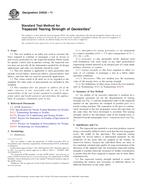Potrebujeme váš súhlas na využitie jednotlivých dát, aby sa vám okrem iného mohli ukazovať informácie týkajúce sa vašich záujmov. Súhlas udelíte kliknutím na tlačidlo „OK“.
ASTM D4533-11
Standard Test Method for Trapezoid Tearing Strength of Geotextiles
Automaticky preložený názov:
Štandardná skúšobná metóda pre různoběžníku Trhanie Pevnosť geotextíliou
NORMA vydaná dňa 1.6.2011
Informácie o norme:
Označenie normy: ASTM D4533-11
Poznámka: NEPLATNÁ
Dátum vydania normy: 1.6.2011
Kód tovaru: NS-27613
Počet strán: 5
Približná hmotnosť: 15 g (0.03 libier)
Krajina: Americká technická norma
Kategória: Technické normy ASTM
Anotácia textu normy ASTM D4533-11 :
Keywords:
Trapezoid tearing test, Geosynthetics, Destructive testing--soil/rock, Felt, Strength--geosynthetics, Tear testing--geosynthetic materials/applications, ICS Number Code 59.080.70 (Geotextiles)
Doplňujúce informácie
| Significance and Use | ||||||||||||
|
The trapezoid tear method is a test that produces tension along a reasonably defined course such that the tear propagates across the width of the specimen. The trapezoid tearing strength for woven fabrics is determined primarily by the properties of the yarns that are gripped in the clamps. In nonwoven fabrics, because the individual fibers are more or less randomly oriented and capable of some reorientation in the direction of the applied load, the maximum trapezoid tearing strength is reached when the resistance to further reorientation is greater than the force required to rupture one or more fibers simultaneously. The trapezoid tearing strength method is useful for estimating the relative tear resistance of different fabrics or different directions in the same fabric. This test method may be used for acceptance testing of commercial shipments; however, caution is advised since information about between-laboratory precision is incomplete. Comparative tests as directed in 5.3.1 may be advisable. In case of a dispute arising from differences in reported test results when using this test method for acceptance testing of commercial shipments, the purchaser and the supplier should conduct comparative tests to determine if there is a statistical bias between their laboratories. Competent statistical assistance is recommended for the investigation of bias. As a minimum, the two parties should take a group of test specimens that are as homogeneous as possible and that are from a lot of material of the type in question. Test specimens should then be randomly assigned in equal numbers to each laboratory for testing. The average results from the two laboratories should be compared using the appropriate Student's t-test and an acceptable probability level chosen by the two parties before testing is begun. If a bias is found, either its cause must be found and corrected or the purchaser and the supplier must agree to interpret future test results in the light of the known bias. Most geotextile fabrics can be tested by this test method. Some modification of clamping techniques may be necessary for a given fabric, depending upon its structure. Special adaptation may be necessary with strong fabrics, or fabrics made from glass fibers, to prevent them from slipping in the clamps or being damaged as a result of being gripped in the clamps. This test method may be used with constant-rate-of-traverse (CRT) or constant-rate-of-extension (CRE) type tension machines. However, there may be no overall correlation between the results obtained with the CRT machine and the CRE machine. Consequently, these two tension testers cannot be used interchangeably. In case of controversy, the CRE machine shall prevail. |
||||||||||||
| 1. Scope | ||||||||||||
|
1.1 This test method is an index test used to measure the force required to continue or propagate a tear in woven or non-woven geotextiles by the trapezoid method. While useful for quality control and acceptance testing, the trapezoid tear test does not provide all the information needed for all design applications and other test methods should be used. 1.2 This test method is applicable to most geotextiles that include woven fabrics, nonwoven fabrics, layered fabrics, knit fabrics, and felts that are used for geotextile applications. 1.3 The values stated in SI units are to be regarded as the standard. No other units of measurement are included in this standard. 1.4 This standard does not purport to address all of the safety concerns, if any, associated with its use. It is the responsibility of the user of this standard to establish appropriate safety and health practices and determine the applicability of regulatory limitations prior to use. |
||||||||||||
| 2. Referenced Documents | ||||||||||||
|
Odporúčame:
Aktualizácia technických noriem
Chcete mať istotu, že používate len platné technické normy?
Ponúkame Vám riešenie, ktoré Vám zaistí mesačný prehľad o aktuálnosti noriem, ktoré používate.
Chcete vedieť viac informácií ? Pozrite sa na túto stránku.




 Cookies
Cookies
